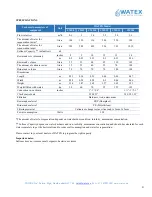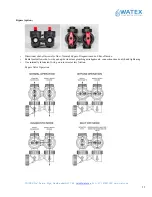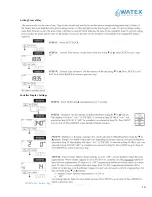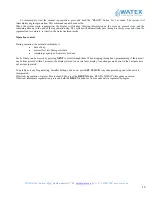
WATEX Ltd., Latvia, Riga, Ganibu dambis 27 k-5,
, Tel. +371 67381989, www.watex.eu
8
INSTALLATION
General conditions
The softener must be placed on the flat, leveled surface.
It is recommended to install the softener in the technical room with sound absorbing, because during the regeneration (usually at
night), the flow of water to the sewers could be heard.
The control valve and connection fittings are not intended for supporting the weight of the water supply system.
All sanitary-technical works to be performed in accordance with local plumbing and electrical codes.
Filter must be provided with a continuous supply of water, which does not differ in quality and quality within 30% and has the
pressure range of 2.0 to 3.5 bar.
The distance between the drain and the water conditioner should be as short as possible.
The room temperature must not be lower than + 5 °C and not higher than 45 °C.
Do not use for the filter connections petroleum jelly, oils, hydrocarbon lubricants or spray silicone. Silicon grease can be used on
black o-type sealing rings, but it is not necessary.
Nuts and bolts have been designed so they can be unscrewed or tightened by hand or special plastic key. If you need to unscrew
the tightened nuts or couplings, you can use pliers. However, take care not to damage the plastic parts. Do not use wrenches or
socket wrenches to tighten or loosen.
Do not place the screwdriver into sleeve/cap openings and do not strike with a hammer!
Teflon tape is not necessary for sewer and reagent connection fittings.
Place the water filter so that the distance between the drainage outlet and the filter is minimized.
Perform a general preventive maintenance at least once a year.
Water pipe connection
In the rear of the water filter is the water supply connection. Each connection has
the inflow and outflow indicating arrows. If you look at the filter from the front, on
the right side is the inflow and on the left side is discharge. The filter’s connection
to the mains outer thread size 1 '' (inch), of both input and output. Plastic threaded
fitting is of a screw type and it can freely rotate the ring, keeping the density.
Therefore, there is no need for very powerful (sufficient hand strength) tightening
of the bolts on the control valve housing.
Use of Teflon tape on the plastic threads is a must.
The material of the piping, which connects to the filter, does not make significant
difference. Most important is that the filter does not bear the weight of the water
supply system.
Filter can be connected with the cast iron, glued, PVC screw-fastening pipes. It is
also possible with flexible metal pipes, soldered brass pipes.
Note: soldering of pipes must be carried out before connection to the control valve plastic fittings failing to follow this rule can
result in internal damage of the plastic fittings and they will not provide consistency of connection.
Soldering fittings must be cooled down. Avoid soldering grease contact with any connecting fitting parts.
For the water filter, it is recommended to install a bypass valve, as shown in the figure, and sample valves before inflow and
outflow as well.
During the normal operation, bypass valve is closed, but the input and an output valves are open.
During the preventive maintenance works on the installation or filter repair, the not purified water can be supplied to the
consumers.
It is recommended to install the sampling valve before and after the filter to compare /determine the quality of raw water and the
just- purified water. It is also advisable to install pressure gauges before and after the filter to control the pressure loss in the
installation.
In order to enhance the durability of the filter first it is recommended to install a mechanical filter that prevents sand particles,
which can be lifted out of the hole and to lead to clogging the parts of the filter.


















